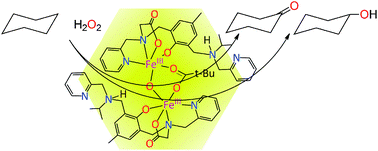A monocarboxylate-bridged diiron(iii) μ-oxido complex that catalyzes alkaneoxidation by hydrogen peroxide†
Abstract
Reaction of the ligand

* Corresponding authors
a
Inorganic Chemistry Research Group, Chemical Physics, Center for Chemistry and Chemical Engineering, Lund University, Box 124, SE-221 00 Lund, Sweden
E-mail:
Ebbe.Nordlander@chemphys.lu.se
b Institute of Problems of Chemical Physics, 142432, Chernogolovka, Moscow district, Russian Federation
c Department of Chemistry, University of Joensuu, P.O. Box 111, FI-80101 Joensuu, Finland
Reaction of the ligand

 Please wait while we load your content...
Something went wrong. Try again?
Please wait while we load your content...
Something went wrong. Try again?
M. Jarenmark, E. A. Turitsyna, M. Haukka, A. A. Shteinman and E. Nordlander, New J. Chem., 2010, 34, 2118 DOI: 10.1039/C0NJ00293C
To request permission to reproduce material from this article, please go to the Copyright Clearance Center request page.
If you are an author contributing to an RSC publication, you do not need to request permission provided correct acknowledgement is given.
If you are the author of this article, you do not need to request permission to reproduce figures and diagrams provided correct acknowledgement is given. If you want to reproduce the whole article in a third-party publication (excluding your thesis/dissertation for which permission is not required) please go to the Copyright Clearance Center request page.
Read more about how to correctly acknowledge RSC content.
 Fetching data from CrossRef.
Fetching data from CrossRef.
This may take some time to load.
Loading related content
